Divine Liturgy
Divine Liturgy (Greek: Θεία Λειτουργία, translit. Theia Leitourgia; Bulgarian: Божествена литургия, romanized: Bozhestvena liturgiya; Georgian: საღმრთო ლიტურგია; Russian: Божественная литургия, tr. 'Bozhestvennaya liturgiya; Polish: Boska Liturgia, Czech: Božská liturgie) or Holy Liturgy[1] is the Eucharistic service of the Byzantine Rite, developed from the Antiochene Rite of Christian liturgy which is that of the Ecumenical Patriarchate of Constantinople. As such, it is used in the Eastern Orthodox, the Byzantine Catholic Churches, and the Ukrainian Lutheran Church.[2] Although the same term is sometimes applied in English to the Eucharistic service of Armenian Christians, both of the Armenian Apostolic Church[3] and of the Armenian Catholic Church,[4] they use in their own language a term[5] meaning "holy offering" or "holy sacrifice".[6] Other churches also treat "Divine Liturgy" simply as one of many names that can be used, but it is not their normal term.[7][8]
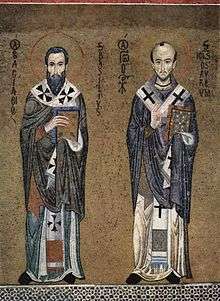
The Greek Catholic and Orthodox Churches see the Divine Liturgy as transcending time and the world. All believers are seen as united in worship in the Kingdom of God along with the departed saints and the angels of heaven. Everything in the liturgy is seen as symbolic, but not merely so, for it makes present the unseen reality. According to Eastern tradition and belief, the liturgy's roots go back to the adaptation of Jewish liturgy by Early Christians. The first part, termed the "Liturgy of the Catechumens", includes like a synagogue service the reading of scriptures and, in some places, perhaps a sermon/homily. The second half, added later, is based on the Last Supper and the first Eucharistic celebrations by Early Christians. Eastern Christians believe that the Eucharist is the central part of the service in which they participate, as they believe the bread and wine truly become the real Body and Blood of Christ, and that by partaking of it they jointly become the Body of Christ (that is, the Church). Each Liturgy has its differences from others, but most are very similar to each other with adaptations based on tradition, purpose, culture and theology.[9][10]
Byzantine Rite
Three Divine Liturgies are in common use in the Byzantine Rite:
- The Divine Liturgy of St. John Chrysostom (5th century), used on most days of the year and as a vesperal liturgy on the Annunciation.
- The Divine Liturgy of St. Basil the Great (4th century), used on the five Sundays of Great Lent and on Saint Basil's feast day (January 1). On the eves of the Nativity and Theophany and on Holy Thursday and Holy Saturday, it is celebrated as a vesperal liturgy. In some traditions, Saint Basil's Liturgy is also celebrated on the Exaltation of the Life-giving Cross on September 14. In all, this liturgy is used 10 times during the liturgical year.
- The Divine Liturgy of the Presanctified Gifts (6th century) is used during Great Lent on Wednesdays, Fridays, and a handful of other occasions, and also on the first three days of Holy Week. Nowadays it is always celebrated as a vesperal liturgy; the Liturgy of the Faithful has no Anaphora (Eucharistic Prayer), the Holy Gifts having been consecrated and reserved ("presanctified") at a previous Divine Liturgy. It is traditionally attributed to St. Gregory the Dialogist, although some scholars believe it originated with Patriarch Severus of Antioch.
As well as these, there are two others that are used locally and rarely, the Liturgy of St. James and the Liturgy of Saint Mark.
The Hierarchical Liturgy
As numbers in a diocese increased dramatically, the bishop who presides over the Eucharistic assembly appointed presbyters to act as celebrants in the local communities (the parishes). Still, the Church is understood in Eastern Orthodoxy in terms not of the presbyter, but the diocesan bishop. When the latter celebrates the liturgy personally, the service is more complex and festive. To demonstrate unity with the greater Orthodox community, the hierarch commemorates the hierarch he is subordinate to or, if he is head of an autocephalous church, he commemorates all his peers, whose names he reads from a diptych.
Typical structure
- Note: Psalms are numbered according to the Greek Septuagint. For the Hebrew Masoretic numbering that is more familiar in the West, usually add '1'. (See the main Psalms article for an exact correspondence table.)
The format of Divine Liturgy is fixed, although the specific readings and hymns vary with season and feast.
The Divine Liturgy consists of three interrelated parts; when not in conjunction with vespers, the liturgies of John Chrysostom and Basil the Great are structured thus:
- the Liturgy of Preparation, which includes the entry and vesting prayers of the priests and deacons and the Prothesis;
- the Liturgy of the Catechumens, so called because traditionally this is the only part they may attend;
- the Liturgy of the Faithful, so called because in ancient times only baptized members in good standing were allowed to participate. In modern times, this restriction applies only to Holy Communion – reception of the sacrament of holy communion.
A typical celebration of the Byzantine Liturgy consists of:
Liturgy of Preparation
This part of the Liturgy is private, performed only by the priest and deacon. It symbolizes the hidden years of Christ's earthly life.
- Entrance and vesting prayers, the sacred servers (priests and deacons) enter the church, venerate the icons and put on their vestments.
- Liturgy of Preparation – the priest and deacon prepare the bread and wine for the Eucharist (see prosphora) at the Table of Oblation (Prothesis).
- Kairos – a preliminary dialog takes place between the priest and the deacon.
Liturgy of the Catechumens
This is the public part of the Liturgy, in which both catechumens and baptized faithful would be in the nave:
| Part of a series on the |
| Catholic Church |
|---|
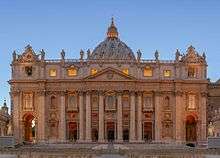 |
| Overview |
|
Miscellaneous
Relations with: |
|
|
- Opening blessing by the priest
- He raises the Gospel Book, making the sign of the cross with it over the Altar and proclaiming:
"Blessed is the kingdom of the Father and of the Son and of the Holy Spirit, now and ever and unto ages of ages", to which the response is "Amen."- Great Litany, beginning with the priest proclaiming, "In peace, let us pray to the Lord", to which the response is "Lord, have mercy."
- First Antiphon
- Little Litany
- Second Antiphon
- "Only-Begotten Son"
- Little Litany
- Third Antiphon
- Small Entrance – procession with the Gospel Book
- Entrance hymn
- Troparia and Kontakia
- Hymns commemorating specific saints and Scriptural events, as appropriate to the liturgical calendar and local custom
- Trisagion, the "Thrice-Holy" hymn (or on certain days, another hymn)
- Prokeimenon
- Epistle Reading
- Alleluia
- Gospel Reading
- Litany of Fervent Supplication – "Let us all say with our whole soul and with our whole mind…"
- Litany for the Departed – this is not said on Sundays, Great Feasts or during the Paschal season
- Litany of the Catechumens, and Dismissal of the Catechumens
Liturgy of the Faithful
In the early Church, only baptized members who could receive Holy Communion were allowed to attend this portion of the Liturgy. In common contemporary practice, with very few local exceptions (e.g., Mount Athos), all may stay. However, in most places, catechumens are formally dismissed for further study.
- First Litany of the Faithful
- Second Litany of the Faithful
- Cherubikon chanted as spiritual representatives (or icons) of the angels
- Great Entrance – procession taking the chalice and diskos (paten) from the Table of Oblation to the altar
- Litany of Completion – "Let us complete our prayer to the Lord"
- The Kiss of Peace
- Symbol of Faith (the Nicene Creed)
- Sursum Corda ("Let us lift up our hearts..." (Greek: "Ἄνω σχῶμεν τὰς καρδίας")
- Anaphora (Eucharistic Prayer)
- The Epinikios Hymnos or Sanctus ("Holy, Holy, Holy…")
- The Eucharistic Canon, containing the Anamnesis (memorial of Christ's Incarnation, death, and Resurrection, and the Words of Institution)
- Epiklesis The calling down of the Holy Spirit upon the Holy Gifts (bread and wine) to change them into the Body and Blood of Christ
- Commemoration of Saints and Theotokion (hymn to the Theotokos)
- It is Truly Meet (Ἀξιόν ἐστιν) (on certain days replaced with various hymns in honor of the Mother of God)
- Commemoration of bishop and civil authorities – "Remember, O Lord…"
- Litany of Supplication – "Having called to remembrance all the saints…"
- Lord's Prayer
- Bowing of Heads
- "Holy Things are for the Holy"
- Communion Hymn
- Holy Communion
- "We have seen the true light"
- "Let our mouths be filled with Thy praise, O Lord…"
- Litany of Thanksgiving
- Prayer behind the Ambon
- Psalm 33
- Dismissal
Almost all texts are chanted throughout the Divine Liturgy, not only hymns but litanies, prayers, creed confession and even readings from the Bible, depending on tradition. In ancient rubrics, and contemporary Greek practice, the sermon, Nicene Creed and the Lord's Prayer are spoken/read, rather than chanted. Slavic traditions chant or sing everything except the sermon.[11]
Gallery of parts of the Eastern Orthodox liturgy
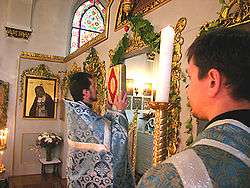 The priest making the Little Entrance with the Gospel Book
The priest making the Little Entrance with the Gospel Book Priest reading the Gospel
Priest reading the Gospel Litany of the Catechumens. The antimension is opened three-quarters of the way; the final portion will be unfolded at the petition: "That He will reveal unto them the Word of Truth."
Litany of the Catechumens. The antimension is opened three-quarters of the way; the final portion will be unfolded at the petition: "That He will reveal unto them the Word of Truth."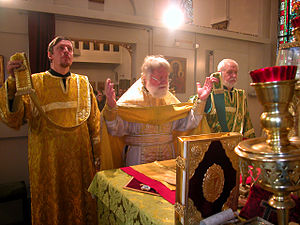 The priest and deacons reciting the Cherubic Hymn (during its public chanting) before the Great Entrance
The priest and deacons reciting the Cherubic Hymn (during its public chanting) before the Great Entrance The priest making the Great Entrance while subdeacon holds censer
The priest making the Great Entrance while subdeacon holds censer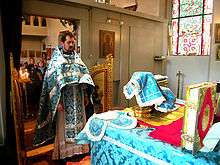 The priest standing at the Holy Table after the Great Entrance
The priest standing at the Holy Table after the Great Entrance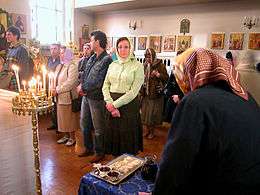 The faithful preparing to receive Holy Communion. In the foreground are wine and antidoron which the communicants will partake of after receiving the Body and Blood of Christ
The faithful preparing to receive Holy Communion. In the foreground are wine and antidoron which the communicants will partake of after receiving the Body and Blood of Christ Distributing Holy Communion to the faithful
Distributing Holy Communion to the faithful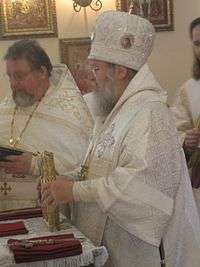 The priest (in this photo, a bishop) makes the Sign of the Cross with the Gospel Book over the antimension after the latter has been folded
The priest (in this photo, a bishop) makes the Sign of the Cross with the Gospel Book over the antimension after the latter has been folded The priest giving the dismissal with the blessing cross
The priest giving the dismissal with the blessing cross
Oriental Orthodox Churches
| Part of a series on |
| Oriental Orthodoxy |
|---|
 |
| Oriental Orthodox churches |
|
Subdivisions
|
|
History and theology
|
|
Major figures
|
|
|
"Divine Liturgy" is the normal word that, in their own languages, followers of the Byzantine Rite apply to their Eucharistic services but, while in English the same word (as also the word "Mass") is at times used to speak of the corresponding services of the Oriental Orthodox Churches, the normal names used in those Churches refers either to the aspect of offering/sacrifice (Qurbana in the Syriac Orthodox Church), Badarak[12] in the Armenian Apostolic Church, Prosfora[13] in the Coptic Orthodox Church) or of sanctifying (Keddase in the Ethiopian Orthodox Tewahedo Church).[6]
The Oriental Orthodox Churches own a richness of different liturgies, which are named after the anaphora included.
Coptic Liturgy
At present, the Coptic Orthodox Church and Coptic Catholic Church have three Liturgies:
- The Liturgy of St. Basil (4th century)
- The Liturgy of St. Mark the Apostle, this liturgy is also known as the Liturgy of St. Cyril
- The Liturgy of St Gregory the Theologian
The Liturgy of St. Basil is celebrated on most Sundays and contains the shortest anaphora. The Liturgy of St. Gregory is usually used during the feasts of the Church but not exclusively. In addition the clergy performing the Liturgy can combine extracts of The Liturgies of St. Cyril and St. Gregory to the more frequently used St. Basil at the discretion of the Priest or Bishop.
The Syriac Orthodox Church, the Syriac Catholic Church, the Syriac Maronite Church of Antioch and the Syro-Malankara Catholic Church of the West Syriac Rite which is developed from the Antiochene Rite use a version of the Divine Liturgy of Saint James which differs substantially from its Byzantine Rite counterpart, most notably in being substantially shorter (it can be completed in under two hours, whereas the historic form of the Byzantine Rite liturgy prior to the revisions of St. Basil and St. John Chrysostom took more than four hours), and in that it can be used with more than eighty different anaphoras; the most commonly used are those of Mar Bar Salibi (which is the shortest), and that of St. James, which resembles that of the Byzantine Rite liturgy, and is mandated on certain occasions, such as major feasts, the consecration of churches, and the first liturgies offered by newly ordained priests.[14] Due to the long isolation of the Saint Thomas Christians the rite of the Syro-Malankara Catholic Church shows some differences, so that this rite is called the Malankara Rite.
The main liturgy used by the Coptic Church is known as Liturgy of Saint Basil.[15] The term Liturgies of Saint Basil in a Coptic context means not only the sole anaphora with or without the related prayers, but also the general order of the Alexandrine Rite liturgy.[16]
Anaphora
The Egyptian (or Coptic) anaphora of Saint Basil, even if related and using the same Antiochene (or "West Syrian") structure,[17] represents a different group from the Byzantine, West Syrian and Armenian grouping of anaphoras of Saint Basil. The Egyptian version does not derive directly from the latter and has its own peculiarities: its text is more brief, with less Scriptural and allusive enhancements, and it lacks well defined Trinitarian references,[18]:113 which are typical of other versions and reflect the theology of the First Council of Constantinople of 381.
The structure of the Bohairic Coptic version used today in the Coptic Church can be summarized as follow:
- Anaphora:
- the Opening Dialogue
- the Preface, praising Father as Lord and everlasting king, as creator of heaven and earth, the sea and all that is in them,[19] and as Father of Christ by whom all things were made
- the Pre-Sanctus, praising the Father on his throne of glory and worshiped by the Angelic hosts, so introducing
- the Sanctus, conducted without the Benedictus
- the Post-Sanctus, recalling the whole history of Salvation, from the Original Sin to the Incarnation, Passion, Resurrection of Christ up to the Last Judgment
- the Institution narrative
- the Anamnesis, referring to the Passion, Resurrection and Second Coming of Christ
- the Oblation, offering to the Father the Eucharistic gifts
- the Epiclesis, asking the Holy Spirit to come and to sanctify and manifest the gifts as the Most Holy; then asking the Holy Spirit to make the bread the Body and the chalice the Blood of Christ
- the Intercessions, praying for the participants to become one single body, for the Church, for the Pope of Alexandria and for all the ecclesiastic hierarchy, for the town and the harvest, for the floodings, for the living, for who have offered the Eucharistic gifts, for the saints – naming Mary, John the Baptist, Saint Stephen, Saint Mark and Saint Basil; then reading of the diptychs, followed by the prayers for the dead
- a prayer for the fruit of the Communion and the final doxology.
The 7th-century Sahidic Coptic version found in 1960[20] shows an earlier and more sober form of the Bohairic text: the manuscript, incomplete in its first part, begins with the Post Sanctus, and is followed by a terse Institution narrative, by a pithy Anamnesis which simply lists the themes and ends with the oblation. The next Epiclesis consists only of the prayer to the Holy Spirit to come and manifest the gifts, without any explicit request to change the gifts in the Body and Blood of Christ. The intercessions are shorter and only Mary is named among the saints.[18]:112
Liturgy of Saint Basil
The term Liturgy of Saint Basil may refer also to the whole Eucharistic Liturgy which in the Coptic Church has the following structure:[21][22]
Offertory
Offertory (or Prothesis) is the part of the liturgy in which the Sacramental bread (qorban) and wine (abarkah) are chosen and placed on the altar. All these rites are Middle-ages developments.[23]
It begins with the dressing of the priest with vestments and the preparation of the altar, along with prayers of worthiness for the celebrant. At this point is chanted the appropriate hour of the Canonical hours, followed by the washing of the hands with its prayer of worthiness, and by the proclamation of the Nicean Creed.
Then takes place the elaborate rite of the choosing of the Lamb: while the congregation sing 41 times the Kyrie eleison, the priest checks the wine and chooses among the bread one loaf which will be consecrated (the Lamb). The Lamb is cleaned with a napkin and blessed with the priest's thumb wet with wine. Afterwards the priest takes the Lamb in procession around the altar and the deacon follows with the wine and a candle.[15] At the altar, the priest, with appropriate prayers, blesses the Lamb and the wine, places the Lamb on the Paten and pours wine and a few drops of water in the chalice (the chalice is placed on the altar in a wooden box named ark).
The last part of the offertory resembles an anaphora: after a dialogue, the priest blesses the congregation and proclaims a prayer of thanksgiving, giving thanks to God for his support to us, and asking him for a worthy participation to the liturgy. Then comes the prayer of covering said inaudibly by the priest, which has the form of an epiclesis asking God to show his face on the gifts, and to change them in order that the bread and wine may became the Body and Blood of Christ. This text might come from an ancient anaphora or simply be a later High Middle Ages creation.[23] The paten and the ark with the chalice inside are here covered with a veil.
Liturgy of the Catechumens
In the Liturgy of the Catechumens the readings from the New Testament are proclaimed. This portion was in ancient times the beginning of the liturgy, and the only part which could be attended by the catechumens. It is roughly equivalent to the Liturgy of the Word in the Western Rites.
It begins with a Penitential Rite in which first the priest prays inaudibly to Christ for the forgiveness of sins (The Absolution to the Son) and then all the participants kneel in front of the altar and the celebrant, or the bishop if present, recites a prayer of absolution (The Absolution to the Ministers).
The reading from the Pauline epistles is preceded by the offering of incense at the four sides of the altar, at the iconostasis, at the book of the Gospel and at the faithfuls in the nave; in the meantime the faithful sing a hymn to Mary and a hymn of intercession. The Pauline epistle is followed by a reading from the Catholic epistles and by one from the Acts of the Apostles. Another offering of incense is conduced (the Praxis Incense), similar to the Pauline incense except that only the first row of the faithful is incensed. A reading from the Coptic Synaxarium can follow.
After these readings, the Trisagion is sung three times, each time with a different reference to the Incarnation, Passion, Resurrection, thus addressing the Trisagion to Christ only. After the Trisagion follows a litany, the recital of a Psalm and the singing of the Alleluia, and finally the proclamation of the Gospel from the doors of the sanctuary. The sermon may follow.
Liturgy of the Faithful
The Liturgy of the Faithful is the core of the Liturgy, where are placed the proper Eucharistic rites.
It begins with the prayer of the Veil,[23] in which the priest offers the liturgical sacrifice to God. The Long Litanies follows, where all pray for the peace, for the ecclesiastic hierarchy and for the congregation. The Nicean Creed is proclaimed, the priest washes his hands three times and sprinkles water on the congregation reciting the Prayer of Reconciliation which is a prayer of worthiness for all who attend the liturgy. Next is the Kiss of peace during which the faithful sing the Aspasmos Adam (Rejoice O Mary) hymn.
The Anaphora is conducted. After the anaphora takes place the consignation,[23] i.e. the moistening of the Lamb with some drops of the consecrated Wine, which is shown for the worship of the faithful. The Fraction of the consecrated Lamb ensues, during which the priest says a prayer which varies according to the Coptic calendar. All of the congregation stands and prays with open hands the Lord's Prayer.
To be prepared for partaking of the Eucharist, the faithful bow while the celebrant says in low voice the prayer of submission, then the priest and the participants offer each other a wish of peace and the priest inaudibly prays to the Father for the forgiveness of sins (The Absolution to the Father).
The Elevation is similar to that in the Byzantine Rite, with the celebrant who raises the portion of the Lamb engraved with a cross (the ispadikon) crying: "The holy things for the holy ones". The priest makes a second consignation and puts gently the ispakidon in the chalice (the commixture),[24] then he recites aloud a confession of faith. The partaking of the Eucharist follows, first the Body of Christ given to the celebrants, to the deacons and to the faithful who approach the sanctuary without shoes and then the Blood of Christ in the same order. Psalm 150 is sung in the meantime. The distribution of the Eucharist ends with a blessing with the Paten.
The dismissal rites include The Prayer of Laying the Hands and the final blessing.
Armenian Liturgy
The Armenian Apostolic Church and the Armenian Catholic Church have at present a single liturgical structure, called the Armenian Rite, with a single anaphora (the Athanasius-Anaphora)[25] for the liturgy: Holy Patarag or in Western Armenian Holy Badarak, meaning 'sacrifice'. This is in distinction from the other liturgies of the Oriental Orthodox Churches (Coptic, West Syrian, Ethiopic) which have retained multiple anaphora.
This means that the text of the Patarag can be contained in a single, unified liturgical book, the Պատարագամատոյց (Pataragamatooyts, Western Armenian Badarakamadooyts, meaning 'the offering of sacrifice'). This book contains all of the prayers for the Patarag assigned to the bishop (if celebrating as a bishop), the celebrating priest, the deacon(s), and the people, the last typically led by a choir with accompaniment.
Before the end of the 10th century there were also other liturgical forms, such as the Anaphora of St. Basil, the Anaphora of St. Gregory the Illuminator and others in use.[26][27][28][29][30][31]
The elements of the Armenian eucharistic liturgy reflect the rich set of influences on Armenian culture. The roots of the liturgy lie in the West Syrian and Byzantine forms, with the influence of the Roman Catholic Mass, the latter having arrived likely during the period of the Fourth Crusade or shortly thereafter.
Among the distinctive practices of the Armenian Patarag is the tradition that on the Sundays of the fast before Easter (the Great Fast) the curtain which hangs down in front of the elevated altar area (Armenian խորան khoran) is never opened – even for the reading of the Gospel, certain movable parts of the liturgy are omitted, the parts of the liturgy sung by the choir are said or chanted simply without adornment, there is no general confession, and there is no distribution of Communion to the faithful. This practice of fasting from the Communion bread in preparation for Easter may reflect an ancient custom of the church in Jerusalem. A special prayer of repentance is sung by the clergy on the morning of Palm Sunday (Armenian: Ծաղկազարդ tsaghkazard, Western Armenian dzaghgazard), after which the curtain is opened for the first time since the last Sunday before the Great Fast.
One element which almost certainly derives from the influence of Western liturgy is the reading of a last Gospel at the conclusion of the Patarag. However, the celebration of a short memorial service for one or more departed persons (Հոգեհանգիստ hogehangist, Western Armenian hokehankist, meaning 'rest of the spirit') is quite prevalent in parishes and replaces the reading of the last Gospel.
East Syrian Churches
The Assyrian Church of the East, the Ancient Church of the East and their larger Catholic counterparts (the Chaldean Catholic Church and the Syro-Malabar Catholic Church), which use the East Syriac Rite that they all inherit from the Church of the East, employ one or more of three different Eucharistic anaphoras when celebrating Holy Qurbana:
- Anaphora of Addai and Mari (or The Hallowing of the Apostles, i.e., of the Apostles Saint Addai and Saint Mari)
- The Hallowing of Theodore of Mopsuestia, attributed to Theodore of Mopsuestia
- The Hallowing of Nestorius, attributed to Nestorius
References
- Romanian: Sfânta Liturghie; Serbian: Света Литургија, romanized: Sveta Liturgija
- Hämmerli, Maria; Mayer, Jean-François (23 May 2016). Orthodox Identities in Western Europe: Migration, Settlement and Innovation. Routledge. p. 13. ISBN 9781317084914.
- Western Diocese|Home Archived 2006-08-24 at the Wayback Machine
- "Armenian Catholic Church in Russia | Welcome!". 2002-11-10. Archived from the original on 2002-11-10. Retrieved 2019-02-13.
- Armenian: Սուրբ Պատարագ, romanized: Surb Patarag, pronounced Sourp Badarak in Western Armenian
- Bradshaw, Paul F.; Johnson, Maxwell E. (2012-06-01). The Eucharistic Liturgies: Their Evolution and Interpretation. Liturgical Press. ISBN 9780814662663.
- William S. Pregnall, Laity and Worship (Seabury Press 1975), p. 117}
- O'Collins, Gerald J.; Farrugia, Mario J. (2014-12-25). Catholicism: The Story of Catholic Christianity. OUP Oxford. ISBN 9780191043925.
- "OCA Q&A on the Divine Liturgy". Archived from the original on 2009-06-06. Retrieved 2009-06-04.
- "Greek Orthodox Archdiocese in North America: Worship". Retrieved 2009-06-04.
- Krivoshein, Basil (2 July 1975). "Some differences between Greek and Russian divine services and their significance". Holy Trinity Cathedral. Retrieved 5 July 2013.
- Hovhanessian, Vahan (2011), "Badarak (Patarag)", The Encyclopedia of Christian Civilization, American Cancer Society, doi:10.1002/9780470670606.wbecc0112, ISBN 9780470670606
- From Greek προσφορά
- Archdeacon Murad Barsom (1997-12-01). "Anaphora of St. James, First Bishop of Jerusalem". Sor.cua.edu. Retrieved 2013-12-31.
- Chaillot, Christine (2006). "The Ancient Oriental Churches". In Wainwright, Geoffrey (ed.). The Oxford history of Christian worship. Oxford New York: Oxford University Press. pp. 137–9. ISBN 9780195138863.
- Cody, Aelred (1991). "Anaphora of Saint Basil". The Coptic encyclopedia. 1. Macmillan. 121b-123b. ISBN 978-0028970257.
- Mazza, Enrico (1995). The origins of the Eucharistic prayer. Collegeville, Minn: Liturgical Press. p. 612. ISBN 9780814661192.
- Stuckwish, D. Richard (1997). "The Basilian anaphoras". In Bradshaw, Paul F. (ed.). Essays on early Eastern eucharistic prayers. Collegeville, Minn: Liturgical Press. ISBN 978-0814661536.
- Psalm 146:6
- J.Doresse and E. Lanne, Un témoin archaique de la liturgie copte de S.Basile, Louvain, 1960
- Sleman, Abraam (ed.). "St. Basil Liturgy Reference Book" (PDF). CopticChurch.net. Retrieved 27 May 2012.
- Malaty, Tadrous Y. (1973). Christ in the Eucharist. OrthodoxEbooks. p. 119.
- Spinks, Bryan (2010). "Oriental Orthodox Liturgical Traditions". In Parry, Ken (ed.). The Blackwell Companion to Eastern Christianity. Malden, Mass: Wiley-Blackwell. pp. 361–2. ISBN 9781444333619.
- "The Fraction in The Coptic Orthodox Liturgy". britishorthodox.org. Archived from the original on 9 March 2012. Retrieved 9 June 2012.
- Hans-Jürgen Feulner: Die armenische Athanasius-Anaphora. Kritische Edition, Übersetzung und liturgievergleichender Kommentar. Pontificio Istituto Orientale, Roma 2001. ISBN 88-7210-332-0.
- Gabriele Winkler: Die Basilius-Anaphora. Edition der beiden armenischen Redaktionen und der relevanten Fragmente, Übersetzung ..., Pontificio Istituto Orientale, Roma 2005, ISBN 88-7210-348-7. - Die ältere Redaktion trägt bei den Armeniern den Namen Gregors des Erleuchters.
- P. Ferhat: Denkmäler altarmenischer Messliturgie 1. Eine dem hl. Gregor von Nazianz zugeschrieben Liturgie. In: Oriens Christianus NS 1 (1911) 201-21
- P. Ferhat: Denkmäler altarmenischer Messliturgie 2. Die angebliche Liturgie des Katholikos Sahaks. In: Oriens Christianus NS 3 (1913) 16-31.
- A. Baumstark: Denkmäler altarmenischer Messliturgie 3. Die armenische Rezension der Jakobusliturgie. In: Oriens Christianus NS 7-8 (1918) 1-32.
- A. Rücker: Denkmäler altarmenischer Messliturgie 4. Die Anaphora des Patriarchen Kyrillos von Alexandreia. In: Oriens Christianus 3. Ser. 1 (1927) 143-157.
- A. Rücker: Denkmäler altarmenischer Messliturgie 5. Die Anaphora des heiligen Ignatius von Antiochien. In: Oriens Christianus 3. Ser. (1930) 56-79.
External links
| Wikimedia Commons has media related to Divine Liturgy. |
- Greek Liturgies; English translation of the Principal Liturgies
- Charles Anthony, Swainson, ed. (1884). The Greek liturgies: Chiefly from original authorities. With an appendix containing the Coptic ordinary canon of the mass from two manuscripts in the British Museum, edited and translated by Dr. C. Bezold. Cambridge: Cambridge University Press. At the Internet Archive.
- Brett, Thomas, ed. (1838) [1720]. A collection of the Principal Liturgies: Used in the Christian church in the celebration of the Holy Eucharist. Particularly the Ancient, viz. the Clementine, as it stands in the book called the Apostolical Constitutions; the Liturgies of St. James, St. Mark, St. Chrysostom, St. Basil, &c. Translated into English by several hands. With a dissertation upon them. London: London : Rivington. At the Internet Archive.
- Eastern Orthodox Christian
- The Divine Liturgy of St. John Chrysostom in English
- The Divine Liturgy of St. John Chrysostom in English
- The Divine Liturgy of St. Basil the Great in English
- The Divine Liturgy of the Presanctified in English
- The Divine Liturgy of St. James the Holy Apostle and Brother of the Lord in English (ancient, early Liturgy)
- The Lenten Liturgies in English
- The Divine Liturgies Music Project Byzantine music in English for the Liturgies of St. John, St. Basil, St. James and the Presanctified
- The Divine Liturgy of the Russian Orthodox Church in English/Church Slavonic, including music (midi, mp3)
- Photos of Divine Liturgy from Russia
- The Divine Liturgy of St. John Chrysostom in Hellenistic New Testament Greek (Koine) and Modern Demotic Greek
- The Divine Liturgy of St. John Chrysostom as it practised daily, in Koine Greek
- The Divine Liturgy of St. John Chrysostom as it practised at Sundays, in Koine Greek
- The Divine Liturgy of St. John Chrysostom as it practised with a deacon, in Koine Greek
- The Divine Liturgy of St. Basil the Great in Koine Greek
- The Divine Liturgy of St. James Presanctified, in Koine Greek
- Textos litúrgicos ortodoxos Spanish translations of the Orthodox Liturgical texts (Serbian Patriarchate)
- Oriental Orthodox Christian
- The Divine Liturgy of the Syriac Orthodox Church
- Download Coptic/Arabic Holy Liturgies in mp3 format from St-Takla.org
- Coptic Liturgy of St. Basil Full text with explanations and commentary
- Coptic Liturgy of St. Mark Full text (also known as the Liturgy of St. Cyril)
- Coptic Liturgy of St. Gregory Full text with footnotes
- Ethiopian Divine Liturgy
- Armenian Divine
- In Remembrance of the Lord
- Arak29 Badarak (Armenian Divine Liturgy)
- Armenian Badarak Commentary
- Analysis of the Armenian Divine Liturgy